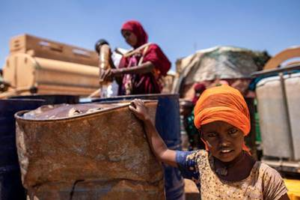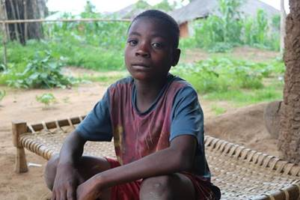Save the Children warns that drastic action is needed to ensure children and their families can cope with current and future climate-shocks


From left: Sahra* (8) and her family have been impacted by the drought in Somalia; Baptista* (14) and his family in Mozambique have struggled since Cyclone Kenneth.
Toronto, 18 April – An estimated 710 million children[i][i] live in the 45 countries that are at the highest risk of suffering the impact of climate change, Save the Children warned today. Floods, droughts, hurricanes and other extreme weather events will have an especially deep impact on vulnerable children and their families. Children in these countries will be impacted by food shortages, diseases, water scarcity, or be at risk from rising water levels – or a combination of these factors.
Indigenous children across the globe are on the frontlines of climate change. In Canada, the north is warming at twice the rate of the global average. This means that for First Nations, Inuit and Metis children, their communities and nations are experiencing vastly increased frequency and severity of floods, wildfires, food insecurity and a range of health implications. First Nations children in Canada are almost 30 times more likely to be displaced by climate change than their non-Indigenous counterparts.
An analysis by Save the Children of ND-Gain data[ii][ii] shows that globally, hundreds of millions of children under the age of 18 are living in regions where climate change is deeply affecting their lives – with girls being disproportionately affected. The impact of the crisis on food production is likely to lead to local food scarcity and price hikes, Save the Children said, with devastating impacts on the poorest households.
The window to prevent catastrophic climate change is rapidly closing as the crisis is set to worsen[iii][iii] unless urgent action is taken now, Save the Children said. Children must be heard in the climate crisis–conversation and should be involved in shaping policies, the organization urged.
“What I really can’t forget is that I saw many houses falling because of too much rain and strong winds. I got scared. I don’t know why all that rain fell and there was a gale wind. I didn’t like that because afterwards we were left homeless and without food.” 14-year-old Baptista* in Mozambique told Save the Children. He and his three siblings have struggled to recover ever since Cyclone Kenneth struck their town in 2019.
As U.S. President Joe Biden holds a Leaders summit on climate change starting on Earth Day (22 April), Save the Children urged that children, including the most marginalized must be heard alongside world leaders who are joining the summit.
Analysis by Save the Children also shows that:
- 70 percent of countries facing a high risk of climate impact are in Africa;
- Climate change impacts are worsening the already dire situation in Yemen, where conflict has created severe food shortages, leaving millions of children at risk of hunger;
- Children in Bangladesh are highly exposed to flooding, cyclones, and sea levels rise;
While all children are impacted by climate change, those living in poverty, conflict or hunger, or in disaster prone areas, will suffer most as they often are already deprived of their basic needs. Girls are often particularly affected. Children in countries deemed at a “lower-risk” are facing threats as well, for example from forest fires, flooding, droughts and other erratic weather events.
“The climate crisis is the largest threat to children and the realization of their rights across borders and generations. The COVID-19 outbreak has already pushed millions of children and families into poverty and increased hunger and malnutrition. But flooding, hurricanes and droughts are also causing children to be malnourished,” said Danny Glenwright, President and CEO of Save the Children.
Glenwright added: “Children have contributed the least to the crisis we are facing, but will pay the highest price. We have seen the power of children, leading the way on climate change through a truly global movement. But much more must be done – we need to listen to children and governments must take action based on what children tell them. Policymakers need to set up child-friendly mechanisms and platforms on- and off-line to include children’s recommendations in climate policies, including the perspectives of the most vulnerable children.”
Ahead of the Climate Summit on Earth Day, Save the Children urges all governments to take immediate and drastic action to address climate injustice head on, and avoid further catastrophic impacts on children and their families. This includes:
- Acknowledging that the climate crisis is a child rights crisis
- Increase climate finance, particularly for adaptation, with a specific focus on children in poorer countries, given as grants.
- Ensure a focus on children, especially from the most marginalized communities, at upcoming Climate events such as the Youth Summit in Milan and the COP26 in the Glasgow later this year.
- Scale up adaptive and shock-responsive social protection systems – such as grants for pregnant mothers and children – to address the increasing impacts of climate change on children and their families.
Save the Children calls on the Government of Canada to ensure a comprehensive focus on children, especially the most marginalized and deprived groups, in international and national climate related frameworks and policies. All children, including Indigenous children and their rights, are explicitly included in Canada’s national climate priorities and plans.
ENDS
For more information or to arrange an interview please contact: Jessica Bryant, Head of Communications, Media and PR:
*Names changed to protect children’s identities
Notes to Editors:
Methodology: The ranking of countries is from Notre Dame Global Adaptation Initiative (ND-GAIN), 2018 (latest dataset). We have extracted all countries with the 25% lowest adaptation score, making these countries at high risk of climatic shocks compared to other countries. For these 45 countries, we used the UN Population data for the year 2021 calculated the children population (age 0-17).
ND-GAIN considers six areas that are likely to be affected by climate change: ecosystem, food, health, human habitat, infrastructure and water. ND-GAIN is using projected trends calculated against the RCP4.5 scenario. According to the IPCC, RCP 4.5 requires that carbon dioxide (CO2) emissions start declining by approximately 2045 to reach roughly half of the levels of 2050 by 2100.
[iv][i] Children of 0-17 years of age
[v][ii] Notre Dame GAIN
[vi][iii] Climate risks are based upon the intermediate scenario of RCP 4.5 https://sedac.ciesin.columbia.edu/ddc/ar5_scenario_process/RCPs.html
Media Contact
For additional information please contact Jessica Bryant, Head of Communications, Media and PR:
About Save the Children
Save the Children believes every child deserves a future. In Canada and around the world, we give children a healthy start in life, the opportunity to learn and protection from harm. We do whatever it takes for children – every day and in times of crisis – transforming their lives and the future we share.


